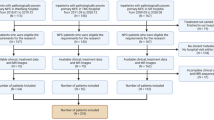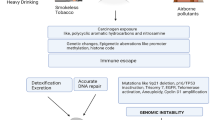Abstract
Nasopharyngeal carcinoma is a unique tumour which is endemic in southern China including Hong Kong. Whilst the treatment results for the primary cancer has been encouraging, management of recurrent tumours has been challenging. Compared to other surgical approaches, the maxillary swing operation provides wide access to the bilateral nasopharynx and the ipsilateral parapharyngeal space, allowing resection of tumours with adequate margins. Among the 312 patients who had received salvage nasopharyngectomy via the maxillary swing approach, the chance of achieving microscopically clear resection margins was 79.5 %. The overall local recurrence rate after surgery was 13.1 %. Multivariate analysis showed that resection margin status, synchronous nodal recurrence and cavernous sinus invasion were independent prognostic factors for overall survival. For small tumours located in the posterior wall, endoscopic resection, or more recently, the transoral robotic (TORS)-assisted approach, can be performed. Every effort should be made to ensure microscopic clearance of disease as well as to minimize the potential complications of surgery that may adversely affect the subsequent quality of life.


Similar content being viewed by others
References
Papers of particular interest, published recently, have been highlighted as: • Of importance •• Of major importance
Luo J, Chia KS, Chia SE, et al. Secular trends of nasopharyngeal carcinoma incidence in Singapore, Hong Kong and Los Angeles Chinese population, 1973–1997. Eur J Epidemiol. 2007;22:513–21.
Lin JC, Jan JS, Hsu CY, et al. Phase III study of concurrent chemoradiotherapy versus radiotherapy alone for advanced nasopharyngeal carcinoma: positive effect on overall and progression-free survival. J Clin Oncol. 2003;21:631–7.
Chan JY, Wei WI. Critical appraisal of maxillary swing approach for nasopharyngeal carcinoma. Expert Opin Ther Targets. 2012;16 Suppl 1:S111–7.
Yu KH, Leung SF, Tung SY, Zee B, Chua DT, Sze WM, et al. Survival outcome of patients with nasopharyngeal carcinoma with first local failure: a study by the Hong Kong Nasopharyngeal Carcinoma Study Group. Head Neck. 2005;27(5):397–405.
Fee Jr W, Moir M, Choi EC, et al. Nasopharyngectomy for recurrent nasopharyngeal cancer: a 2- to 17-year follow-up. Arch Otolaryngol Head Neck Surg. 2002;128:280–4.
Wu SX, Chua DT, Deng ML, et al. Outcome of fractionated stereostatic radiotherapy for 90 patients with locally persistent and recurrent nasopharyngeal carcinoma. Int J Radiat Oncol Biol Phys. 2007;69:761–9.
Leung TW, Tung SY, Sze WK, Sze WM, Wong VY, Wong CS, et al. Salvage radiation therapy for locally recurrent nasopharyngeal carcinoma. Int J Radiat Oncol Biol Phys. 2000;48:1331–8.
Lin YC, Wang WH. Narrow-band imaging for detecting early recurrent nasopharyngeal carcinoma. Head Neck. 2011;33(4):591–4.
Wang WH, Lin YC, Chen WC, Chen MF, Chen CC, Lee KF. Detection of mucosal recurrent nasopharyngeal carcinomas after radiotherapy with narrow-band imaging endoscopy. Int J Radiat Oncol Biol Phys. 2012;83(4):1213–9.
King AD, Bhatia KS. Magnetic resonance imaging staging of nasopharyngeal carcinoma in the head and neck. World J Radiol. 2010;2(5):159–65.
Chan AT, Ma BB, Lo YM, et al. Phase II study of neoadjuvant carboplatin and paclitaxel followed by radiotherapy and concurrent cisplatin in patients with locoregionally advanced nasopharyngeal carcinoma: therapeutic monitoring with plasma Epstein-Barr virus DNA. J Clin Oncol. 2004;22:3053–60.
Chan JY, Chow VL, Mok VW, Ho AC, Wei WI. Prediction of surgical outcome using plasma Epstein-Barr virus DNA and 18F-FDG PET-CT scan in recurrent nasopharyngeal carcinoma. Head Neck. 2012;34(4):541–5.
Wang CC, Busse J, Gitterman M. A simple afterloading applicator for intracavitary irradiation of carcinoma of the nasopharynx. Radiology. 1975;115(3):737–8.
Harrison LB, Weissberg JB. A technique for interstitial nasopharyngeal brachytherapy. Int J Radiat Oncol Biol Phys. 1987;13(3):451–3.
Wilson CP. The approach to the nasopharynx. Proc R Soc Med. 1951;44:353–8.
Derome PJ. The transbasal approach to tumours invading the base of the skull. In: Schmidek HH, Sweet WH, editors. Operative neurosurgical techniques, vol. I. New York: Grune and Stratton; 1982. p. 357–9.
Van Buren JM, Ommaya AK, Ketcham AS. Ten years’ experience with radical combined craniofacial resection of malignant tumors of the paranasal sinuses. J Neurosurg. 1968;28:341–50.
Fish U. The infratemporal fossa approach for nasopharyngeal tumors. Laryngoscope. 1983;93(1):36–44.
Morton RP, Liavaag PG, McLean M, Freeman JL. Transcervico-mandibulo-palatal approach for surgical salvage of recurrent nasopharyngeal carcinoma. Head Neck. 1996;18(4):352–8.
Schuller DE, Goodman JH, Brown BL, Frank JE, Ervin-Miller KJ. Maxillary removal and reinsertion for improved access to anterior cranial base tumors. Laryngoscope. 1992;102:203–12.
Wei WI, Lam KH, Shan JS. New approach to the nasopharynx: the maxillary swing approach. Head Neck. 1991;13(3):200–7.
Chan JY, Chow VLY, Tsang RKY, Wei WI. Nasopharyngectomy for locally advanced recurrent nasopharyngeal carcinoma: exploring the limits. Head Neck. 2012;34(7):923–8. The article describes the need for resecting the advanced tumour en-bloc with the fascia on the surface of the internal carotid artery in order to achieve a clear margin. Traditionally these cancers are associated with a poor local control after surgery because of the inadequate resection.
Chan JY, To VS, Chow VL, Wong ST, Wei WI. Multivariate analysis of prognostic factors for salvage nasopharyngectomy via the maxillary swing approach. Head Neck. 2014;36(7):1013–7. The article reports on the prognostic factors for salvage nasopharyngectomy for recurrent NPC. Distant failure is the major limit in outcome after surgery for recurrent T4 tumours in the nasopharynx.
Chan JY, Wei WI. Recurrent nasopharyngeal carcinoma after salvage nasopharyngectomy. Arch Otolaryngol Head Neck Surg. 2012;138(6):572–6.
Chan JY, Tsang RK, Wei WI. Morbidities after maxillary swing nasopharyngectomy for recurrent nasopharyngeal carcinoma. Head Neck. 2014. doi:10.1002/hed.23633.
Chan JY, Chow VL, Wei WI. Quality of life of patients after salvage nasopharyngectomy for recurrent nasopharyngeal carcinoma. Cancer. 2012;118(15):3710–8.
Ng RW, Wei WI. Elimination of palatal fistula after maxillary swing procedure. Head Neck. 2005;27:608–12.
Chen MY, Hua YJ, Wan XB, et al. A posteriorly pedicled middle turbinate mucoperiosteal flap resurfacing nasopharynx after endoscopic nasopharyngectomy for recurrent nasopharyngeal carcinoma. Otolaryngol Head Neck Surg. 2012;146(3):409–11.
Chen MY, Wang SL, Zhu YL, et al. Use of a posterior pedicle nasal septum and floor mucoperiosteum flap to resurface the nasopharynx after endoscopic nasopharyngectomy for recurrent nasopharyngeal carcinoma. Head Neck. 2012;34(10):1383–8.
Yoshizaki T, Wakisaka N, Nurono S, Shimizu Y, Furukawa M. Endoscopic nasopharyngectomy for patients with recurrent nasopharyngeal carcinoma at the primary site. Laryngoscope. 2005;115:1517–9.
Chen MK, Lai JC, Chang CC, Liu MT. Minimally invasive endoscopic nasopharyngectomy in the treatment of recurrent T1-2a nasopharyngeal carcinoma. Laryngoscope. 2007;117:894–6.
Chen MY, Wen WP, Guo X, et al. Endoscopic nasopharyngectomy for locally recurrent nasopharyngeal carcinoma. Laryngoscope. 2009;119:516–22.
Ko JY, Wang CP, Ting LL, Yang TL, Tan CT. Endoscopic nasopharyngectomy with potassium-titanyl-phosphate (KTP) laser for early locally recurrent nasopharyngeal carcinoma. Head Neck. 2009;331(10):1309–15.
Wrinstein GS, O’Malley Jr BW, Snyder W, Sherman E, Quon H. Transoral robotic surgery: radical tonsillectomy. Arch Otolaryngol Head Neck Surg. 2007;133:1220–6.
Weinstein GS, O’Malley Jr BW, Snyder W, Hockstein NG. Transoral robotic surgery: supraglottic partial laryngectomy. Ann Otol Rhinol Laryngol. 2007;116:19–23.
Park YM, Lee WJ, Lee JG, et al. Transoral robotic surgery (TORS) in laryngeal and hypopharyngeal cancer. J Laparoendosc Adv Surg Tech A. 2009;69:S125–8.
Wei WI, Ho WK. Transoral robotic resection of recurrent nasopharyngeal carcinoma. Laryngoscope. 2010;120:2011–4.
Tsang RK, Ho WK, Wei WI. Combined transnasal endoscopic and transoral robotic resection of recurrent nasopharyngeal carcinoma. Head Neck. 2012;34:1190–3.
Compliance with Ethics Guidelines
Conflict of Interest
Jimmy Yu Wai Chan has received an Area of Excellence Research Grant.
Human and Animal Rights and Informed Consent
This article does not contain any studies with human or animal subjects performed by any of the authors.
Author information
Authors and Affiliations
Corresponding author
Additional information
This article is part of the Topical Collection on Head and Neck Cancers
Rights and permissions
About this article
Cite this article
Chan, J.Y.W. Surgical Salvage of Recurrent Nasopharyngeal Carcinoma. Curr Oncol Rep 17, 8 (2015). https://doi.org/10.1007/s11912-014-0433-x
Published:
DOI: https://doi.org/10.1007/s11912-014-0433-x




